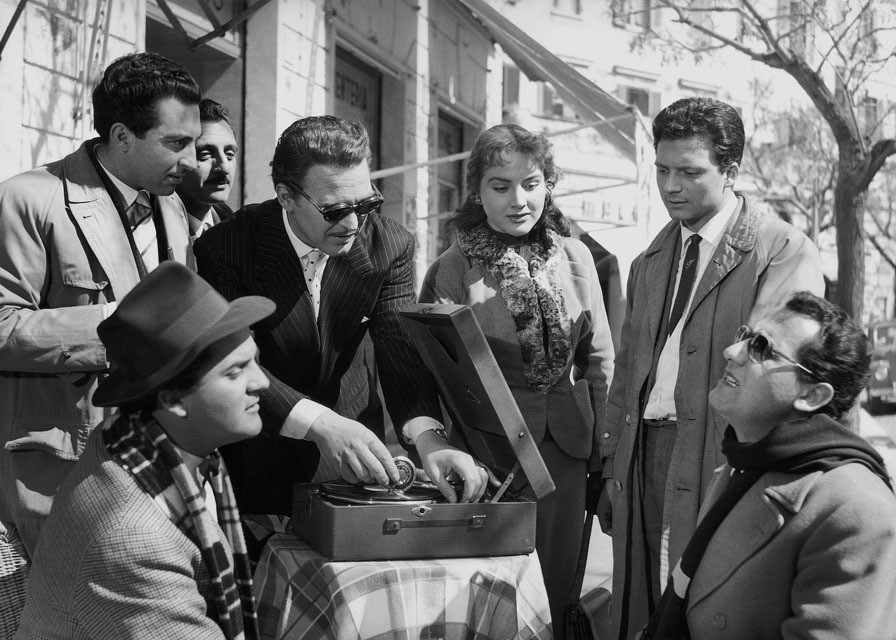“… A voice-over strengthens the film’s links with autobiography: an unidentified vitellone, haunted by his own ghosts, guides us through these images from a world with limited horizons.That’s a good analysis. All the chapters about the films up to 8 ½, plus Amarcord, remind me of how much I love Fellini.
[…] The neologism vitelloni conveys the idea of a bunch of insipid characters, forever trapped in the planning phase without really knowing what to do with their lives. As prisoners of their own little world, incapable of moving beyond it, they are travellers going nowhere. The 5 main characters represent different aspects of provincial mediocrity. […]
All these characters wear masks, to deceive the world around them and to try to control it. […] These 3 events allow Fellini to pinpoint the sadness of the vitelloni, trapped behind the walls of their own indolence. It is not just they lie; what is worse is that they lie to themselves.”

Out of interest, I looked at Wikipedia to search for some other definitions of vitelloni.
Fellini himself said, they were “the unemployed of the middle class, mother’s pets. They shine during the holiday season, and waiting for it takes up the rest of the year”.
Ennio Flaiano, co-writer of I vitelloni, explained further:
“The term vitellone was used in my day to define a young man from a modest family, perhaps a student – but one who had either already gone beyond the programmed schedule for his coursework, or one who did nothing all the time... I believe the term is a corruption of the word vudellone, the large intestine, or a person who eats a lot. It was a way of describing the family son who only ate but never 'produced' – like an intestine, waiting to be filled.”Angel Quintana writes about Il bidone, aka The Swindle:
“Its characters are continuations of the layabouts of I vitelloni. As the economic miracle had introduced a Protestant work ethic into Mediterranean culture, these good-for-nothings find themselves obliged to do something with their lives. So, they become conmen.”Years later, the vitellone reappear in Amarcord:
“Titta and his friends form a group of nascent vitelloni who hang around on the streets, participate in the town’s festive events, bask in the lights and shadows of the Fulgor cinema and dream of make-believe paradise by spying on the people in the Grand Hotel. Women occupy a special place in this world…”Fellini made films out of his own dreams, desires, frustrations, and obsessions. He himself was a vitellone, so we keep seeing the image of vitelloni in his films.
Somehow, I’m also thinking of the main character in La Dolce Vita and 8 ½, both played by Marcello Mastroianni. They are not very different; in a sense, they’re like the grown-up version of the vitellone, travellers going nowhere, prisoners of their own world (of la dolce vita—the sweet life), wracked with guilt but unable to escape from themselves.

At least Guido in 8 ½ is able to come to terms with himself, to some extent, and make a film in the end. Marcello in La Dolce Vita gets sucked into the life of pointless debauchery and hedonism—in the end, he’s pushed even further into that life, after the shocking murder and suicide of the man that he has always believed to have a perfect, ideal life. In the end, Marcello doesn’t understand the girl—he has forgotten his own aspirations. He’s trapped.
About La Dolce Vita, Quintana puts it nicely:
“A dream-like heaviness hangs over every scene, which invariably ends with a painful return to reality, as if every pleasurable situation inevitably has to end in post-coital sadness.”
i don't know if there's much of that in this country... unless politicians fit that description... i know some of them do...
ReplyDeleteYou live in the US, right?
ReplyDeleteIt depends on the culture and society. I don't think American society allows that.
i think you're right about that... we used to before the republicanrats took over...
ReplyDeleteIt’s not so much, perhaps, that Marcello can’t understand the girl at the end of La Dolce Vita, he cant hear her in the first place. Just like, at the very start of the film, he couldn’t hear the girls because of the noise of the helicopters. But there’s a difference, of course. At the start of the film, he girls were merely objects. At the end, the girl represents a vision of something vaguely glimpsed. But as before, he still can’t hear.
ReplyDeleteHe can't hear, but he doesn't get it when she tries to use body language either.
ReplyDelete